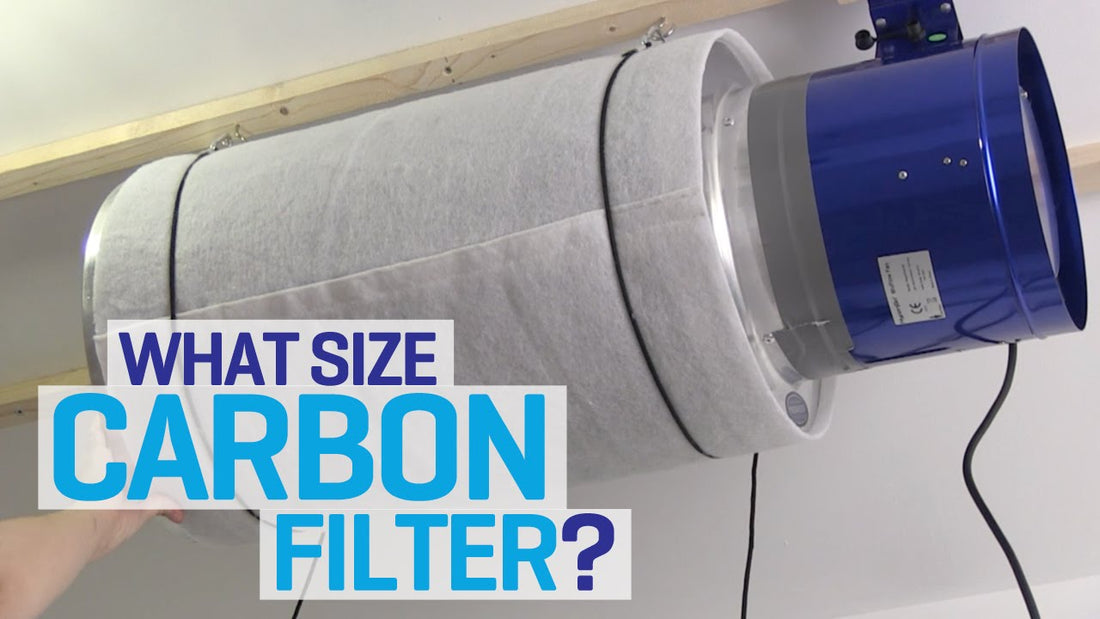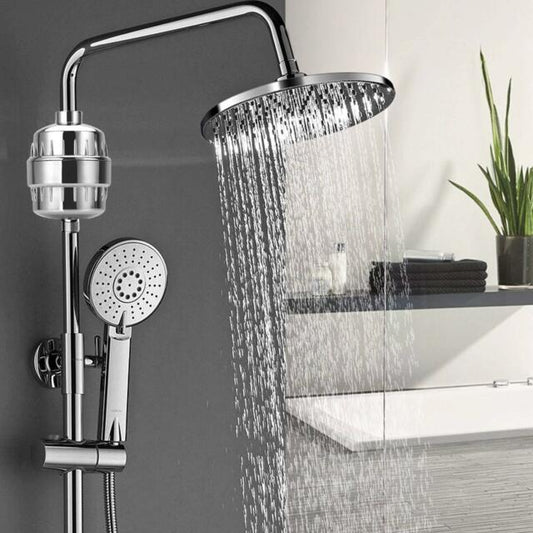Carbon water filters help your water taste and smell better by removing unwanted, dangerous contaminants.
Water quality is important for living a long, healthy life. Picking the right carbon water filter, then, is just as important as diet and exercise.
However, whole house water filtering – including, of course, carbon water filters – can be complicated, to say the least. In this guide, we’re going to review the science behind carbon water filters and offer you some tips on what factors you need to know to evaluate the best carbon water filter for your home.
What is carbon water filtration?
While researching carbon water filtration, you’re apt to fall down a rabbit hole of jargon that’s nearly impossible to successfully navigate without a degree in chemical engineering. It seems like some water softening companies want to confuse and impress you with long-winded explanations. The gist seems to be that the less you understand it, the more likely they are to make a sale.
We want to do things a little bit differently.
We’re going to break it down using concepts and metaphors in order to make the science as simple as possible so that you can get down to your real goal: buying a high-quality whole house water filter that works for your specific situation. Different cities treat their water differently, so the impurities and unwanted byproducts can be vastly different in say, New York and Florida -- especially depending on the soil.
That’s part of the reason why you need to understand carbon water filtration before you buy. You need to know what carbon water filters can and cannot do if you want to buy something that works for you.
So, going back to the original question: What is carbon water filtration?
Carbon water filters use adsorption to remove impurities from drinking water.
Already, just from that sentence alone, there are several branches of questions and concepts that we need to cover:
1. What is adsorption?
2. Why “activated” carbon and not just “normal” (non-activated) carbon?
3. Are all impurities removed by activated carbon?
4. Who cares? Why does it even matter?
Let’s go through them one by one.
What is adsorption?
Adsorption is similar to absorption.
We all know what happens when something absorbs something else: just like a sponge soaking up water, one material (or liquid or molecule or compound or whatever) is encased in another material. Meanwhile, during the process of adsorption, one material adheres to the surface of another material.
In order to picture absorption, think about a misty window in the fall or winter months. Warm water molecules (like the ones inside of your air-conditioned home) cling to the surface of cold glass, causing condensation. The glass doesn’t absorb the water molecules, of course. They just roll off the window.
Carbon water filters work in the same way. Activated carbon is the window, while impurities are the water molecules that stick to the outside of them, making it easier to renew the media. Just like wiping off a window’s condensation with a rag, you can “wipe off” collected contaminants from a carbon filter so that it lasts longer. It’s much more difficult to clean off a sponge than it is to clean a window.
Now that you understand what adsorption is, hopefully you understand a little bit more about why adsorption is a good thing for carbon water filters: it makes them easier to renew, and therefore it reduces maintenance costs.
Next, let’s explore why activated carbon is better than non-activated carbon:
Why “activated” carbon and not just normal, “non-activated” carbon?
Simple. Activated carbon has a larger surface area than non-activated carbon. To extend the metaphor we’ve been using, just picture a bigger window. Naturally, a bigger window is going to attract more water.
By “activating” carbon, you increase the surface area of every carbon molecule. According to the American Physical Society, one gram of activated carbon has a surface area of roughly 32,000 square feet. Furthermore, coconut-shell activated carbon, like the industry-leading Jacobi carbons that FilterSmart uses, have more micropores than charcoal or wood-activated carbons, making it the most optimal choice when it comes to carbon water filtration.
That means that a good amount of possible contaminants – chlorine, volatile organic compounds, and chloramines – will no longer be infecting your water supply. That means that your water will taste better, smell better, and will no longer be injurious to your and your loved one’s health.
But, with that said, not all impurities are removed by carbon water filtration alone.
Are all impurities removed by carbon water filtration? Which are and which aren’t?
As we mentioned above, chlorine, chloramines, volatile organic compounds, taste, and odor are easily removed (and optimized, in the case of taste and odor) by carbon water filtration.
The EPA has a definitive list of contaminants that are removed by granulated carbon alone.
It’s almost impossible to say which compounds are a problem in your area, but we can give you a general idea based on the most popular contaminants across the United States. According to the Water Quality Association, the following contaminants are the most ubiquitous:
· Aluminum
· Ammonia
· Arsenic
· Barium
· Cadmium
· Chloramine
· Chromium
· Copper
· Fluoride
· Bacteria & Viruses
· Lead
· Nitrates/Nitrites
· Mercury
· Perchlorate
· Radium
· Selenium
· Silver
· Uranium
Carbon water filters remove THM, which are unwanted chlorine byproducts, VOCs like arsenic and benzene, pesticides, herbicides, phosphate, lithium, pharmaceuticals, and more.
For contaminants that aren’t filtered by activated carbon, like salts, sediments, and other unhealthy, undesirable minerals (like sodium), it’s best to find a whole house water filter system that comes with a sediment prefilter.
Luckily, all FilterSmart systems come equipped with a sediment prefilter to capture the larger silt and sediment that carbon filters are usually not well-equipped to handle. This comes with the added benefit of extending the lifetime of the carbon filtration media, as well.
Before we go into how to evaluate the efficacy of carbon filtration against other water filtration systems on the market, let’s answer one big, glaring question:
Who cares? Why does any of this even matter?
For one, according to the US Geological Survey, water is literally 60% of the human body. Statistically, you are more water than you are you. You´ll consume more water than any other substance in your lifetime. The average person will consume roughly 30,000 gallons in his or her lifetime.
Naturally, it makes sense to pay attention to your main water source. You should know what contaminants are possibly affecting your health, and you should invest in the right filter to rid your body of those contaminants. Your body, after all, is mostly water.
So why do you need to understand adsorption and carbon filtration before buying a filter? Because if you don’t understand those concepts, you’re likely to make a mistake when it comes to choosing the right filter for your needs. Since water is so important for your health, making a mistake could mean seriously damaging your body.
If you didn’t know how adsorption works, for instance, and if you didn’t know that you need a sediment prefilter to catch larger minerals and sediments before they come out of your faucet, you would be at risk for consuming large amounts of those contaminants.
What is the most effective type of carbon water filter?
Carbon filters remove a host of various contaminants from your water supply, but which one is the most effective?
Generally, there are two types of carbon water filters:
-
Granular activated carbon
-
Carbon blocks
Of the two, carbon blocks have a higher contaminant removal ratio. Solid block activated carbon has been grounded into a mesh that´s anywhere from 7 to 9 times greater than granular activated carbon. However, it might slow down your flow rate.
So, even though carbon blocks technically have a greater surface area than granular activated carbon, that doesn´t mean that granular activated carbon can´t also get the job done, especially if it´s coconut shell activated. Coconut shell activated carbons are the most renewable, and that´s why they´re the industry leading standard.
Conclusion: Carbon Water Filters -- The Comprehensive Guide
How does carbon filtration work?
Carbon filtration works through a process called adsorption. A bed of activated carbon attracts unnecessary water contaminants and impurities, like chlorine, VOCs, and more, improving the taste and smell of the water.
Adsorption is essentially similar to absorption, except the material or compound or liquid adheres to the surface of the medium, and not inside of it. Instead of a sponge soaking up water, think of adsorption like a window in the winter, attracting warm water molecules to its surface.
When it comes to water filtering, this adsorption process makes medium renewal easier. Think about wiping a dirty window off with a rag. It’s much easier than trying to completely squeeze a sponge dry of any liquid at all. If you choose a carbon water filter, the process of adsorption guarantees that your medium, whether granulated or block carbon, will last that much longer. That means a more effective filter for less money.
However, not all compounds and contaminants are removed by carbon filtration. For the compounds that aren’t filtered by carbon, opt for a system that comes with a sediment pre-filter. The benefits are two-fold: 1. Thicker, bigger sediment is filtered more effectively, and 2. Since that same sediment never reaches the carbon media, the carbon media’s lifespan will be much longer. Even though it might mean a greater up-front cost, it will result in significant savings over time.
Finally, focusing this closely on carbon filtration is important because your body is 60% water. Water is literally the #1 substance you will voluntarily consume over your lifetime (as opposed to air, which happens automatically). Therefore, it deserves a significant investment of your time and energy
And, when it comes to the best carbon filtration out there, coconut-shell-activated carbon is the industry leader. It’s more easily renewable than any other type of carbon.
Questions? Concerns? Feel free to get in touch:
Call us: 866.455.9989
Email us: sales@filtersmart.com






